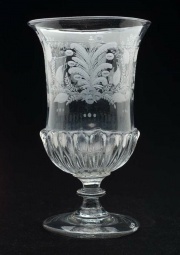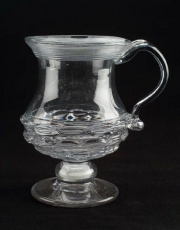Difference between revisions of "Flint glass"
Jump to navigation
Jump to search
| (One intermediate revision by the same user not shown) | |||
| Line 2: | Line 2: | ||
== Description == | == Description == | ||
| − | An optical quality glass with a high refractive index and low dispersion. Flint glass was a typically a [[potash-lead glass]] used for optical lenses and crystal glassware. However, since the manufacture and disposal of | + | An optical quality glass with a high refractive index and low dispersion. Flint glass was a typically a [[potash-lead glass]] used for optical lenses and crystal glassware. However, since the manufacture and disposal of leaded glass is a source of pollution, modern flint glass contains a wide variety of non-lead metal oxides including [[titanium dioxide]] and [[zirconium oxide]]. Flint glass is used for lenses in microscopes, telescopes, binoculars, cameras, prisms, and other imagining instruments. |
See also [[crystal glass|crystal]]. | See also [[crystal glass|crystal]]. | ||
| Line 25: | Line 25: | ||
== Resources and Citations == | == Resources and Citations == | ||
| − | * Wikipedia: [https://en.wikipedia.org/wiki/Flint_glass | + | * Wikipedia: [https://en.wikipedia.org/wiki/Flint_glass Flint glass] (Accessed Oct. 2023) |
* G.S.Brady, ''Materials Handbook'', McGraw-Hill Book Co., New York, 1971 Comment: p. 383 | * G.S.Brady, ''Materials Handbook'', McGraw-Hill Book Co., New York, 1971 Comment: p. 383 | ||
* Walter C. McCrone, John Gustave Delly, ''The Particle Atlas'', W. McCrone Associates, Chicago, IV, 1972 | * Walter C. McCrone, John Gustave Delly, ''The Particle Atlas'', W. McCrone Associates, Chicago, IV, 1972 | ||
Latest revision as of 08:51, 21 October 2023
Description
An optical quality glass with a high refractive index and low dispersion. Flint glass was a typically a Potash-lead glass used for optical lenses and crystal glassware. However, since the manufacture and disposal of leaded glass is a source of pollution, modern flint glass contains a wide variety of non-lead metal oxides including Titanium dioxide and Zirconium oxide. Flint glass is used for lenses in microscopes, telescopes, binoculars, cameras, prisms, and other imagining instruments.
See also crystal.
Synonyms and Related Terms
cristal de chumbo com potássio (Port.)
Physical and Chemical Properties
| Melting Point | 630 C (softens) |
|---|---|
| Density | 2.9-5.9 g/ml |
| Refractive Index | 1.45-2.00 |
Resources and Citations
- Wikipedia: Flint glass (Accessed Oct. 2023)
- G.S.Brady, Materials Handbook, McGraw-Hill Book Co., New York, 1971 Comment: p. 383
- Walter C. McCrone, John Gustave Delly, The Particle Atlas, W. McCrone Associates, Chicago, IV, 1972
- Susan E. Schur, Conservation Terminology: A review of Past & Current Nomenclature of Materials, Technology and Conservation, Spring (p.34-39); Summer (p.35-38); Fall (p.25-36), 1985
- Dictionary of Building Preservation, Ward Bucher, ed., John Wiley & Sons, Inc., New York City, 1996

